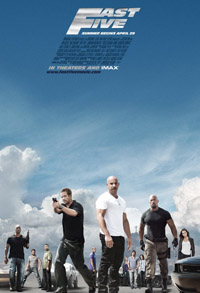"Fast" As Opposed To "Furious" Five
I saw Fast Five on Tuesday, in large measure because I haven't seen a movie in a while, and in small measure because after watching the trailers I just had to know how the two leads survive that 200-foot plunge into the water below.
 I had been thinking of the film as "Furious Five" but that was actually a direct-to-DVD mini-sequel to Kung Fu Panda. One of these two films has predictable dialog, physics-defying action sequences, and genre-specific tropes. The other one is animated.
I had been thinking of the film as "Furious Five" but that was actually a direct-to-DVD mini-sequel to Kung Fu Panda. One of these two films has predictable dialog, physics-defying action sequences, and genre-specific tropes. The other one is animated.
The cliff-jump in question ends with our heroes splashing safely into the water. Mythbusters forever ruined that stunt for me. From that height the water might as well be concrete. This meant that early in the film (this was the second big action scene) the viewer is effectively told "physics don't apply anymore." It's a good thing, because by the end of the film anyone giving so much as a nod to the coefficient of friction, let alone the formula for computing the net forces of dry friction, would suffer an aneurysm watching that 10-ton safe get pulled around town by a pair of muscle-cars.
Homework assignment: Compare the dry friction of a 10-ton steel safe with a 35-square-foot contact patch on a rough concrete surface. Compare that to the dry friction of four, fat, "performance" automobile tires on two, one-ton, rear-wheel drive cars). Assume the tires are smokin' and sticky. Now answer the following question: Assuming unlimited engine power to the wheels, is it possible for those two cars to move the safe?
As some of you may have already seen me say on my Twitter feed, the film was really boring anytime the actors were talking. Once the action started it was actually kind of dull. I don't know why it failed to generate any tension for me, but I suspect it's because part of my brain was out back trying to work out the physics. Fast Five comes in rather penultimately on my 2011 list, just above Season of the Witch.


